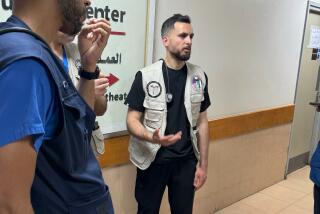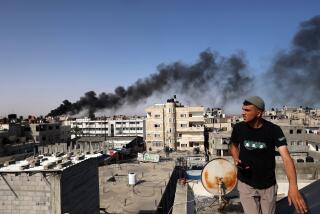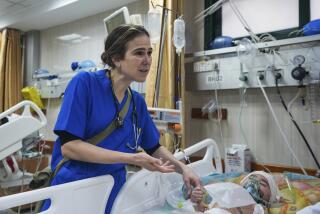Frustrated U.S. Doctors Get OK to Treat Quake Victims
KOBE, Japan — After a long day of heartache and confusion, a group of 18 Southern California trauma-care specialists finally received the go-ahead late Monday to become the first foreigners to treat critically injured victims of the Kobe earthquake.
The word came at midnight just as the success of their mission seemed imperiled. The eight volunteer doctors, nine nurses and single paramedic organized by a Torrance businessman had spent their first day in Kobe feeling frustrated. Accustomed to working 14-hour shifts during disasters at their Southland hospitals, they had been relegated to a minor role by Kobe health authorities. Their only real contact with victims had been at a school converted into a hospital-shelter.
Late Monday, some members of the group even considered giving up and returning to California.
“We shouldn’t give the television crews the impression that we are helping people when we really are not,” said Dr. Steve Cantamout, chief of anesthesiology at Northridge Hospital Medical Center. He vowed to leave the next day unless he was given more appropriate work.
But the unexpected intervention of a British-born American living in Tokyo seemed to solve the problem. Japanese authorities finally agreed that physician-nurse teams from the California group could be assigned today to the few standing hospitals in the most badly crippled districts of Kobe.
The incident illustrated the divergent objectives of the U.S. medical personnel and their Japanese hosts.
Discouraged by their first-day experience, a few of the Californians boiled over in open rebellion against Arthur Johnson, the Torrance businessman who had arranged the goodwill trip, and the Japanese government.
Cantamout told Johnson that he was tired of the “dog and pony” show and vowed to leave the next day unless he was allowed to do the job he had come to Japan to do. “I’ve had enough of their bureaucracy,” he added.
His comments briefly stung the group and a raucous argument soon erupted, with some taking Cantamout’s side.
“I’m not here to be a social worker--I don’t need to hold hands. We did nothing today! There weren’t any real patients--just a bunch of sore throats,” said Dr. Mike Hurwitz, a surgeon at UCLA Harbor Hospital.
Others felt the American team had unrealistic goals.
“If you had expectations to do hands-on work, it was your expectations that were wrong,” replied Dr. Barbara Pohlman, an occupational-health specialist from Laguna Niguel.
Caught in the middle were the Asian Americans in the group. Several tried to explain the rift as a U.S.-Japanese culture gap.
“Americans think they’re the good guys and we should ride in on a white horse to help grateful people,” said Michael Hill, a Japanese American who works as a paramedic at the Six Flags Magic Mountain theme park near Valencia. “The Japanese, on the other hand, think saving face is the most important thing, and the effort to control your country and environment tops any individual’s welfare.”
Earlier Monday, the group had trekked to a crowded school where the tragedy of Kobe was seared into their hearts.
More than 500 homeless families were housed in the cold, crowded hallways and classrooms of Azuma Elementary School.
In a second-floor science lab, Japanese doctors had set up a makeshift clinic. Half a dozen patients lay on students’ desks, intravenous fluid dripping into their gaunt arms, the bottles suspended on equipment designed for students’ experiments.
“It looks like the quake set this country’s health care back a century,” said Charles Fife, a Northridge Hospital critical-care nurse.
A Kobe health department official had asked the Americans to go on rounds at Azuma but had apparently not informed the clinic’s doctors. The Japanese doctors were immediately put off when the Americans seemed to strut in like an advancing cavalry without checking in with the site’s supervising physician. It didn’t help that they were tailed by noisy Japanese and U.S. television news crews.
Largely oblivious to the unintended insult, the Americans dove into their work. Soon they had split up into doctor-nurse-translator teams to see quake victims on each of the building’s four floors.
The fittest lined each drafty hallway on their futons. The elderly and infirm--and parents with small children--were crammed into classrooms decorated with forgotten lesson plans and hazy with cigarette smoke. Each family seemed to do what it could to establish a private space in the very public setting by erecting boundaries with flattened cardboard boxes or piling up cans of food to make walls.
In one classroom, Tsuneji Maeda, 75, and his wife, Masa, 73, lay immobile under blankets next to a bright window. The retired tearoom owners had come to Azuma while their daughter tried to put their jumbled but still standing home back in order. Maeda complained to an interpreter of pain around his groin. Northridge emergency-room physician Ed Lowder examined him and discovered tissue damage suffered in a fall. He prescribed aspirin and exercise to a Japanese woman shadowing his team with a notebook, but said the real problem for many was that they seemed “very depressed.”
He moved on. In the next cubbyhole, Tsuneko Miyagawa, 64, delightedly tested her English on the Americans, thanking them for coming to Japan. Then she began to cry describing the broken and unfixable condition of her 103-year-old father and said she had no idea when they would be able to leave the room.
The eyes of Northridge critical-care nurse Luz Martinez began to well up in sympathy. “I wish I had brought more things to help these people--Neosporin, a blood-pressure cuff,” she said. “I had no idea we would be so powerless, so helpless here.”
Martinez is not the type of person to stay powerless for long, however. A sometime County-USC Medical Center nurse who takes pride in her adaptability, she rigged a Rube Goldberg-style contraption to hold an IV drip for a diabetic woman in a room where no stand was available. She stripped a blanket of its cinch cord and looped it around a hook-shaped ceiling bolt.
“Now I feel like I’ve done something worthwhile,” she said.
Still, the Americans felt intense frustration at Azuma. Martinez feared that influenza could sweep through the building--and noted that the most critical public-health benefit Japanese authorities could offer these unlucky citizens would be better air circulation and a smoking ban.
Dehydration also seemed epidemic. Fife said that most patients he visited appeared to be hoarding their bottled water for bathing rather that ingesting. “You have to drink the water, it will help you,” he repeated several times to elderly patients.
After lunch, the doctors and nurses left the building feeling dejected that Japanese authorities had not assigned them a job that better matched their abilities.
“It felt good to give these people a morale boost--a smile and a reassuring hand,” said Chitra Rao, a Northridge critical-care nurse. “But I would have been happier to give them Cepacol or Tylenol. You can see the effects of politics and red tape--it’s very disappointing.”
The clinicians’ anger grew as they were shepherded back to health department offices to await a new assignment that never came. Finally, a section chief sent them home at 3:30 after offering a lukewarm speech of thanks.
Passing block after block of structural damage to high-rises, the group headed to their home base, a Maritime Safety Agency ship docked at Kobe Harbor. After dinner, the debate erupted over what would come next.
In the end, Dr. David Tharp, the British-born American living in Tokyo, seemed to find a resolution.
Tharp had rushed to Kobe at midweek and offered his energies as a translator and mental health specialist. He was assigned to be a liaison between Kobe officials and the U.S. doctors. All day, he’d been trying to referee misunderstandings between them and the stubbornly self-reliant Japanese doctors.
Tharp walked two miles into town at 8 p.m. Monday and spent the next four hours badgering, imploring and shaming international relief officials at Kobe City Hall into preventing a strain in relations by ensuring that the U.S. medical team got more important work to do.
He returned around midnight with good news: The Japanese had agreed to assign physician-nurse teams to the hospitals in some of the most damaged sections of the city. He roused them from their bunks with the news that he’d be waking many at 6:30 for daylong assignments to which they’d have to walk 10 or 12 kilometers.
“These are really desperate places,” he added. “Push a little, and you’ll get as much responsibility as you want.”
* LAWMAKERS CRITICAL: The government is accused of bungling its quake response. A8
More to Read
Sign up for Essential California
The most important California stories and recommendations in your inbox every morning.
You may occasionally receive promotional content from the Los Angeles Times.










